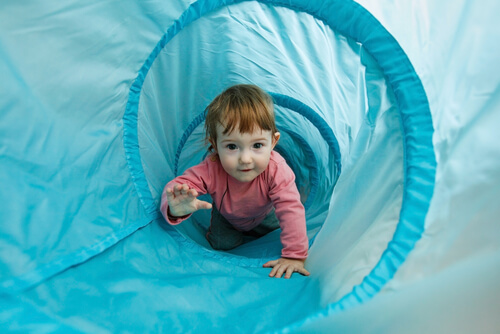What is Deep Pressure Therapy for Kids with Autism?
Feb 7, 2022 Many children with autism also struggle with Sensory Processing Disorder. When sensory input in a child’s environment becomes overwhelming, meltdowns ensue.
To help alleviate meltdowns and calm children with sensory issues and autism, deep pressure stimulation is used.
Deep pressure stimulation is also known as ‘deep touch stimulation.‘ It’s applied pressure to the body that produces a gentle, but firm pressure that promotes relaxation to the nervous system. Think of it as a similar touch to being squeezed in a tight hug. When deep touch is applied to a child’s body, it takes a child from “flight-or-flight” mode to a “restful and calm” state.
Once a restful and calm state is reached with deep pressure stimulation, amazing things begin to happen to your child’s nervous system and their whole body.
Deep touch produces the following benefits:
- Slows the heart rate
- Relaxes muscles
- Improves circulation
- The brain releases endorphins
- Dopamine and serotonin neurotransmitters are released
Research has found that deep pressure therapy increases serotonin levels by 28%, dopamine levels by 31%, and cortisol levels were decreased by 31%. Since “happiness” hormones are increased and the “stress” hormone is decreased, the result is a boost in mood and lower anxiety levels. Deep pressure touch can help significantly when your child is experiencing a meltdown.

Deep Pressure Touch for Sleep Issues
One of the challenging symptoms of autism is problems with sleep. Children with autism tend to have a higher rate of sleep issues compared to their peers.
Some common sleep issues related to autism include:
- Troubles falling asleep
- Insomnia
- Night terrors or sleepwalking
- Restless leg syndrome (RLS)
Although there are more sleep-related issues than the four above, the four sleep issues above could be reduced or resolved with deep pressure stimulation. Such deep pressure touch products as weighted blankets or compression sheets can help a child with autism fall asleep faster and help promote a more restful deep sleep.
Deep pressure stimulation like weighted blankets help reduce cortisol (stress) levels and increase melatonin production. This allows your child to fall asleep faster at bedtime and wake less if he/she continues to use deep pressure throughout the night.
Boost Your Child’s Speech Development!
Improve language & communication skills with fun learning!

When to Use Deep Pressure Stimulation
In all honesty, the choice is up to you! Your child is likely receiving deep pressure stimulation therapy exercises with his/her occupational therapist. But deep touch stimulation can also be used at home to:
- Decrease anxiety
- Reduce arousal levels
- Reduce cortisol levels (stress hormone)
- Increase body awareness
- Reduce hypersensitivity.
While you can always implement deep pressure touch when your child is having a meltdown and needs immediate relief, this type of therapy can potentially reduce an overreaction to sensory input. Deep pressure stimulation is a type of self-calming exercise a child can do themselves. But you may need to help guide your child with the different types of deep pressure touch activities for he/she to do when feeling overwhelmed.

At-Home Deep Pressure Stimulation Activities
- Crawling on hands and knees
- Army crawling
- Bear walk
- Bouncing or laying his/her stomach on a yoga ball
- Crashpad (an oversized plush pad where your child can “crash” on)
- Somersaults
- Cartwheels
- Crawling through a play tunnel
- Weighted products (weighted blankets, stuffed animals, lap pads, ankle weights, etc.)
- Squeezing a stress ball
- Stretching resistance bands
- Jumping on a trampoline
- Deep pressure massage
- Compression clothing
- Heavy work activities (vacuum, mop, carry groceries, etc.)
- Hopping
- Jump rope
- Wall push-ups
- Using a body sock
- Playing in a ball pit
Start Now!
If you haven’t incorporated deep pressure stimulation with your child at home, you need to start! I started using deep pressure touch on my son with autism and I’ve noticed significant improvements. While he is nonverbal and doesn’t fully understand how to do these activities by himself when he’s overwhelmed or anxious, I can simply take out a deep pressure product or activity to help him calm down.
Here’s how I incorporate deep pressure stimulation with my son. As soon as I notice his anxiety increasing, I redirect his attention to one of the following items for deep pressure stimulation:

- Personal indoor trampoline
- Crashpad – Make your own by taking a bed duvet cover and any extra pillows to create a plush pad for jumping and crashing on.
- Weighted blanket
- Ball pit
- Yoga ball
When he uses one of the above deep touch items, his meltdown subsides in minutes! Our go-to product that’s my son’s favorite is a weighted blanket for deep pressure stimulation. By far this approach to redirecting my son to a deep pressure stimulation activity works the best for calming sensory meltdowns.
